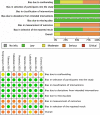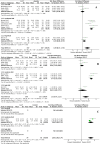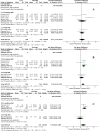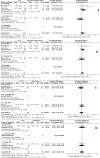Effects of low-level light therapy on dentin hypersensitivity: a systematic review and meta-analysis
- PMID: 34642786
- PMCID: PMC8602177
- DOI: 10.1007/s00784-021-04183-1
Effects of low-level light therapy on dentin hypersensitivity: a systematic review and meta-analysis
Abstract
Objective: To investigate the treatment efficacy of low-level light therapy on dentin hypersensitivity.
Materials and methods: Following the PRISMA guideline, six electronic databases supplemented with bibliographies were searched till December 2020. Two reviewers performed the screenings independently with a reliability assessment. Studies fulfilling the pre-registered eligibility criteria were included for risk-of-bias assessment and data synthesis.
Results: Thirty-five articles ultimately informed this systematic review based on the eligibility criteria and underwent risk-of-bias assessment (ĸ = 0.86). Quantitative results were deduced by meta-analysis of 20 randomised controlled trials: LLLT showed favourable outcomes compared to placebos for immediate (SMD: 1.09, 95% CI: 0.47 to 1.70), interim (SMD: 1.32, 95% CI: 0.41 to 2.23), and persistent efficacies (SMD: 2.86, 95% CI: 1.98 to 3.74). However, substantial heterogeneity existed among included studies (I2: 64-95%). Regarding comparisons with other desensitising strategies, LLLT showed no significant benefits in DH alleviation over others except fluorides for interim efficacy (SMD: 0.31, 95% CI: 0.10 to 0.52) and persistent efficacy (SMD: 0.45, 95% CI: 0.03 to 0.86).
Conclusions: This systematic review shows that LLLT has positive immediate, interim, and persistent DH-treatment efficacies compared with placebo. No superior treatment effects of LLLT were observed except fluoride agent use. Further studies are warranted-RCTs with low risk of bias, consistent technical settings, comprehensive assessments, and long follow-up periods.
Clinical relevance: This systematic review bridges a critical research gap by analysing clinical evidence in the DH-alleviating efficacy of LLLT in comparison with placebo and other in-office desensitising strategies.
Keywords: Dentin hypersensitivity; Low-level light therapy; Meta-analysis; Systematic review.
© 2021. The Author(s).
Conflict of interest statement
The authors declare no competing interests.
Figures







Similar articles
-
Control interventions in randomised trials among people with mental health disorders.Cochrane Database Syst Rev. 2022 Apr 4;4(4):MR000050. doi: 10.1002/14651858.MR000050.pub2. Cochrane Database Syst Rev. 2022. PMID: 35377466 Free PMC article.
-
Low level laser therapy (Classes I, II and III) for treating osteoarthritis.Cochrane Database Syst Rev. 2003;(2):CD002046. doi: 10.1002/14651858.CD002046. Cochrane Database Syst Rev. 2003. Update in: Cochrane Database Syst Rev. 2004;(3):CD002046. doi: 10.1002/14651858.CD002046.pub2. PMID: 12804422 Updated.
-
Low level laser therapy (Classes I, II and III) for treating osteoarthritis.Cochrane Database Syst Rev. 2004;(3):CD002046. doi: 10.1002/14651858.CD002046.pub2. Cochrane Database Syst Rev. 2004. Update in: Cochrane Database Syst Rev. 2007 Jul 18;(1):CD002046. doi: 10.1002/14651858.CD002046.pub3. PMID: 15266461 Updated.
-
Couple therapy for depression.Cochrane Database Syst Rev. 2018 Jun 8;6(6):CD004188. doi: 10.1002/14651858.CD004188.pub3. Cochrane Database Syst Rev. 2018. PMID: 29882960 Free PMC article.
-
Pharmacological interventions for people with borderline personality disorder.Cochrane Database Syst Rev. 2022 Nov 14;11(11):CD012956. doi: 10.1002/14651858.CD012956.pub2. Cochrane Database Syst Rev. 2022. PMID: 36375174 Free PMC article.
Cited by
-
Evaluation of Propolis Hydrogel for the Treatment of Dentinal Sensitivity: A Clinical Study.Gels. 2023 Jun 12;9(6):483. doi: 10.3390/gels9060483. Gels. 2023. PMID: 37367153 Free PMC article.
-
Effect of Low- and High-Level Laser Therapy on the Treatment of Dentin Hypersensitivity: An Umbrella Review.J Lasers Med Sci. 2024 Aug 27;15:e41. doi: 10.34172/jlms.2024.41. eCollection 2024. J Lasers Med Sci. 2024. PMID: 39381788 Free PMC article. Review.
-
Evaluation of dentinal tubule occlusion and pulp tissue response after using 980-nm diode laser for dentin hypersensitivity treatment.Clin Oral Investig. 2023 Aug;27(8):4843-4854. doi: 10.1007/s00784-023-05114-y. Epub 2023 Jun 29. Clin Oral Investig. 2023. PMID: 37382717
-
Effects of Low-Level Laser Therapy on Dentin Hypersensitivity in Periodontally Compromised Patients Undergoing Orthodontic Treatment: A Randomised Controlled Trial.J Clin Med. 2023 Feb 10;12(4):1419. doi: 10.3390/jcm12041419. J Clin Med. 2023. PMID: 36835953 Free PMC article.
-
A Comparative Study on the Safety and Efficacy of Erbium Laser Therapy Versus Traditional Treatments in Managing Dentin Hypersensitivity: An Observational Study.Cureus. 2024 Jul 21;16(7):e65022. doi: 10.7759/cureus.65022. eCollection 2024 Jul. Cureus. 2024. PMID: 39165442 Free PMC article.
References
-
- West NX, Lussi A, Seong J, Hellwig E. Dentin hypersensitivity: pain mechanisms and aetiology of exposed cervical dentin. Clin Oral Invest. 2013;17(1):9–19. - PubMed
-
- Kimura Y, Wilder-Smith P, Yonaga K, Matsumoto K. Treatment of dentine hypersensitivity by lasers: a review. J Clin Periodontol. 2000;27(10):715–721. - PubMed
-
- Ye W, FENG XP, Li R. The prevalence of dentine hypersensitivity in Chinese adults. J Oral Rehabil. 2012;39(3):182–187. - PubMed
-
- Chabanski M, Gillam D, Bulman J, Newman H. Prevalence of cervical dentine sensitivity in a population of patients referred to a specialist Periodontology Department. J Clin Periodontol. 1996;23(11):989–992. - PubMed
Publication types
MeSH terms
Substances
LinkOut - more resources
Full Text Sources
Miscellaneous

